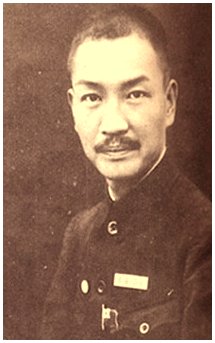Views
m |
m |
||
| Line 23: | Line 23: | ||
Dài married Niǔ Yǒuhéng [[鈕有恆]] in Shànghǎi 上海 in [[1911]]. She was very active in Buddhist practice and her dharma name was Liánhuā 蓮花. She kept a vegetarian diet from [[1929]] and received the precepts from the Panchen lama [[班禪]] in [[1931]]. She died in [[1942]]. | Dài married Niǔ Yǒuhéng [[鈕有恆]] in Shànghǎi 上海 in [[1911]]. She was very active in Buddhist practice and her dharma name was Liánhuā 蓮花. She kept a vegetarian diet from [[1929]] and received the precepts from the Panchen lama [[班禪]] in [[1931]]. She died in [[1942]]. | ||
| - | Dài wrote about 90% of his works related to Buddhist subjects during the period [[1930]]-[[1937]]. He asked | + | Dài wrote about 90% of his works related to Buddhist subjects during the period [[1930]]-[[1937]]. He asked Ōuyáng Jìngwú [[歐陽竟無]] to compile a selection of sutra readings for laypeople, which was published by the China Inner Studies Academy (Zhīnà nèixuéyuàn [[之那內學院]]) in [[1931]] as ''Zàijiā bùdú nèidiǎn'' [[在家必讀內典]]. |
In [[1933]] he took the Dharma name Bùkōng 不空 or Bùkōng Jīngāng 不空金剛 in a Dharma assembly led by the Panchen Lama [[班禪]]. He also received a Bhaisajyaguru (Medicine Buddha; Yàoshī 藥師) lustration (guàndǐng 灌頂) as well as a prediction of future enlightenment (shòujì 授記). | In [[1933]] he took the Dharma name Bùkōng 不空 or Bùkōng Jīngāng 不空金剛 in a Dharma assembly led by the Panchen Lama [[班禪]]. He also received a Bhaisajyaguru (Medicine Buddha; Yàoshī 藥師) lustration (guàndǐng 灌頂) as well as a prediction of future enlightenment (shòujì 授記). | ||
Revision as of 08:28, 20 May 2009
Dài Jìtáo 戴季陶 (1890-1949)
Dài was a politician and ideologue who supported Buddhist activities under the rubric of "National Salvation" (jiùguó 救國).
- Born January 1, 1890 (11/26 Guāngxù 光緒 16) in Guǎnghàn 廣漢, Sìchuān 四川
- Died February 21, 1949 (Mínguó 民國 38) at Guǎngzhōu 廣州, Guǎngdōng 廣東
- Youth name: Liángbì 良弼[1]
- Name 名: Chuánxián 傳賢 (after 1925)
- Style name 號: Tiānchóu 天仇; Xiàoyuán 孝園 (late in life)
- Courtesy names 字: Xuǎntáng 選唐; Jìtáo 季陶
- Dharma name 法名: Bùkōng 不空 or Bùkōng Jīngāng 不空金剛[2]; Búdòng 不動[3]
Biography
Dài was born to a once prosperous family who had moved to Sìchuān from Zhèjiāng 浙江 during his great-great-grandfather's generation. His family made a living as potters and Dai was the youngest of four children, hence his name Jìtáo (Youngest Potter). Dái's mother (née Huáng 黃) taught him Buddhist practice from a young age.
Between 1902 and 1905 he studied in a school in Chéngdū 成都 that prepared students for studying in Japan. He traveled to Japan in 1905 to study law and politics at Nihon Daigaku 日本大学 in Tokyo.
In 1922 he had a dramatic conversion experience during a suicide attempt en route by steamer from Hànkǒu 漢口 to Yíchāng 宜昌. Distraught at not being able to broker a truce between the Sìchuān warlords and Sun Yat-sen, he leaped into the river, only to be saved by a glowing halo of Buddha-light (fóguāng 佛光).
Dài married Niǔ Yǒuhéng 鈕有恆 in Shànghǎi 上海 in 1911. She was very active in Buddhist practice and her dharma name was Liánhuā 蓮花. She kept a vegetarian diet from 1929 and received the precepts from the Panchen lama 班禪 in 1931. She died in 1942.
Dài wrote about 90% of his works related to Buddhist subjects during the period 1930-1937. He asked Ōuyáng Jìngwú 歐陽竟無 to compile a selection of sutra readings for laypeople, which was published by the China Inner Studies Academy (Zhīnà nèixuéyuàn 之那內學院) in 1931 as Zàijiā bùdú nèidiǎn 在家必讀內典.
In 1933 he took the Dharma name Bùkōng 不空 or Bùkōng Jīngāng 不空金剛 in a Dharma assembly led by the Panchen Lama 班禪. He also received a Bhaisajyaguru (Medicine Buddha; Yàoshī 藥師) lustration (guàndǐng 灌頂) as well as a prediction of future enlightenment (shòujì 授記).
In 1940 he visited Buddhist sites in India and attempted to negotiate a political alliance with India against the Japanese based on the common Buddhist heritage of India and China.
From about 1941 he began to suffer from rheumatism (shīqì 濕氣) and inflamed joints because of hiding in ditches during air raids. He often took solace in the fact that Shīlabhadra (Jièxián 戒賢; c. 521-651 CE), who also suffered from great pains, saw a Bodhisattva in a dream who told him that his pain was due to past evil acts, and that if he practiced assiduously he would recover. In 1947 he would write that in the past ten years he had constantly suffered from illness.
Dài committed suicide in Guǎngzhōu 廣州 in 1949 when the victory of the People's Liberation Army was assured.
Important Works
- "The Reform of China's Religions and the Task of National Salvation." Radio Broadcast on National Central Radio, March 22, 1933.
Also see List of Buddhist Works by 戴季陶
Notes
- ↑ Perhaps a rǔmíng 乳名 or a xuémíng 學名
- ↑ The name of Amoghavajra, 705-774 CE
- ↑ Reported by Shì Dōngchū 釋東初, 中國佛教近代史, 下冊 (台北: 中華佛教文化館, 民國63 [1974]), 482.
References:
Chén Tiānxí 陳天錫, ed. and corr. Dài Jìtáo xiānshēng wéncún 戴季陶先生文存. 4 vols. Taipei: Zhōngguó guómíndǎng zhōngyāng wěiyuánhuì, 1959.
Shì Dōngchū 釋東初, ed. Dài Jítáo xiānshēng fóxué lùnjí 戴季陶先生佛學論集. Taipei: Huayan lianshe puti fotang yinhang, 1981.
Shì Dōngchū 釋東初. Zhōngguó fójiào jìndàishǐ 中國佛教近代史, 2 vols. Taipei: Zhonghua fo2jiao wenhua guan, Mínguó 民國63 [1974] (pp. 481-496.) [1]
Lín Jìng 林競 (1894-1962). "Bùkōng jūshì yǔ fójiào 不空居士與佛教" in Zhū Jiāhuá 朱家驊 et al., Dài Jìtáo xiānshēng shìshì shízhōunián jìniàn tèkān 戴季陶先生逝世十週年紀念特刊, [S.l. : s.n.], Mínguó 民國 48 [1959]: 39-44.
